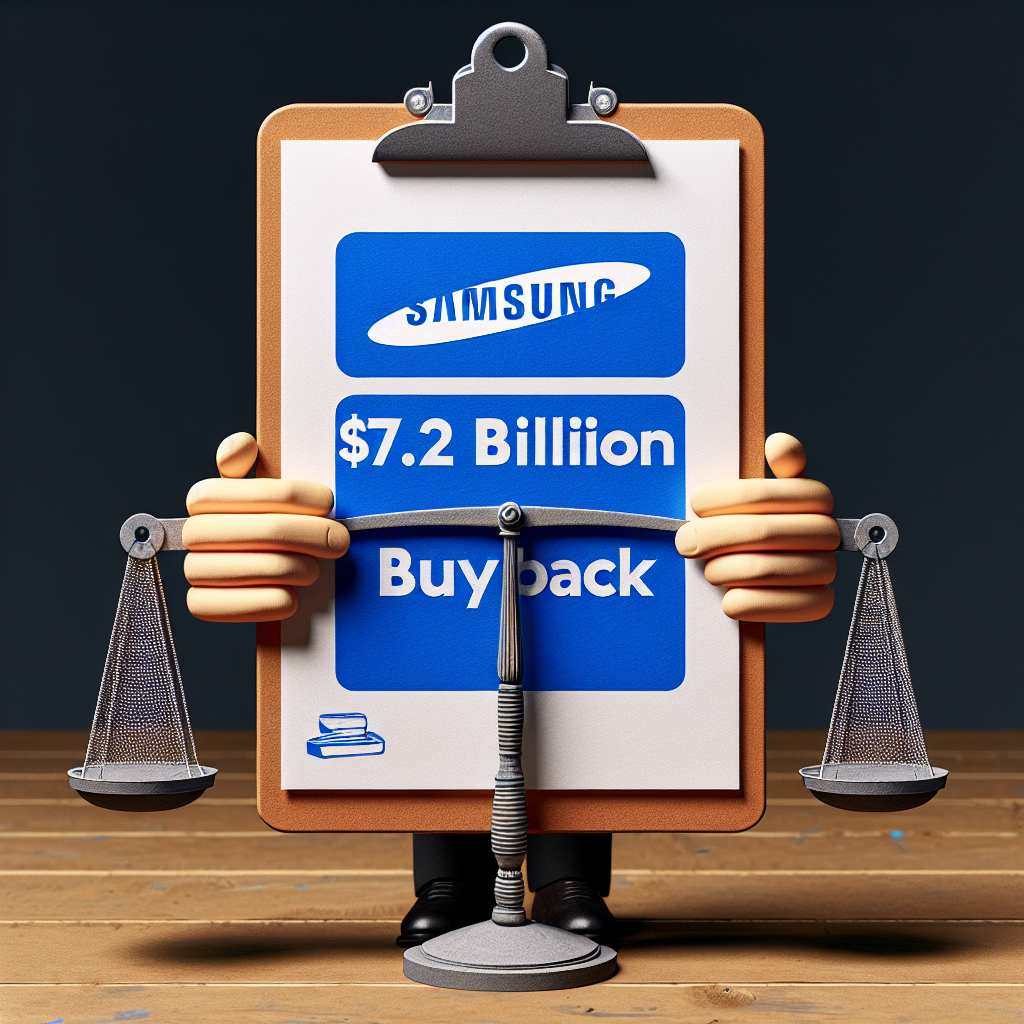“Empowering Growth: Samsung’s $7.2 Billion Buyback Boosts Shareholder Value”
Introduction
Samsung Electronics has announced a significant financial maneuver aimed at bolstering shareholder value through a $7.2 billion share buyback initiative. This strategic move underscores the company’s commitment to returning capital to its investors and optimizing its capital structure. By repurchasing its own shares, Samsung Electronics seeks to enhance earnings per share, provide a more attractive return on equity, and signal confidence in its long-term growth prospects. This buyback is part of a broader strategy to maintain financial flexibility while reinforcing investor confidence in the company’s robust market position and future potential.
Impact Of Samsung’s $7.2 Billion Buyback On Shareholder Value
Samsung Electronics, a global leader in technology and innovation, has recently announced a substantial $7.2 billion share buyback program, a strategic move aimed at enhancing shareholder value. This decision comes at a time when the company is navigating a complex landscape of global economic challenges and intense competition in the technology sector. The buyback is expected to have a significant impact on shareholder value, and understanding its implications requires a closer examination of the factors at play.
To begin with, share buybacks are a common strategy employed by companies to return capital to shareholders. By repurchasing its own shares, a company reduces the number of outstanding shares in the market, which can lead to an increase in earnings per share (EPS). This, in turn, often results in a higher stock price, benefiting shareholders who retain their shares. For Samsung, the decision to initiate a $7.2 billion buyback underscores its confidence in its financial health and future growth prospects. It signals to the market that the company believes its shares are undervalued, making it an opportune time to invest in itself.
Moreover, the buyback is likely to have a positive impact on Samsung’s stock performance. Historically, share repurchase programs have been associated with short-term boosts in stock prices, as they create additional demand for the shares. This can be particularly advantageous for existing shareholders, as the increased demand can drive up the stock price, thereby enhancing the value of their investment. Furthermore, the reduction in the number of shares outstanding can lead to improved financial ratios, such as return on equity (ROE), which can make the company more attractive to investors.
In addition to the immediate financial benefits, the buyback program reflects Samsung’s commitment to maintaining a balanced approach to capital allocation. By returning excess cash to shareholders, the company demonstrates its dedication to rewarding investors while still retaining sufficient resources to invest in research and development, pursue strategic acquisitions, and expand its global footprint. This balanced approach is crucial for sustaining long-term growth and competitiveness in the rapidly evolving technology industry.
However, it is important to consider the potential risks associated with share buybacks. Critics argue that buybacks can sometimes be used to artificially inflate stock prices, potentially at the expense of long-term investment in the company’s core business. In Samsung’s case, the company must ensure that the buyback does not detract from its ability to innovate and adapt to changing market conditions. Maintaining a focus on product development and technological advancements is essential for Samsung to continue its leadership in areas such as semiconductors, consumer electronics, and telecommunications.
In conclusion, Samsung Electronics’ $7.2 billion share buyback is a strategic move designed to enhance shareholder value by increasing earnings per share and potentially boosting stock prices. While the buyback reflects the company’s confidence in its financial position and growth prospects, it also underscores the importance of a balanced approach to capital allocation. As Samsung navigates the challenges of the global technology landscape, it must continue to prioritize innovation and strategic investments to ensure sustained success. Ultimately, the buyback program is a testament to Samsung’s commitment to delivering value to its shareholders while positioning itself for future growth.
Analyzing Samsung’s Strategic Move: $7.2 Billion Buyback
Samsung Electronics, a global leader in technology and innovation, has recently announced a significant strategic move aimed at enhancing shareholder value: a $7.2 billion share buyback. This decision comes at a time when the company is navigating a complex landscape of global economic challenges and intense competition in the technology sector. The buyback is not only a testament to Samsung’s robust financial health but also a strategic maneuver to bolster investor confidence and optimize capital allocation.
The rationale behind this substantial buyback is multifaceted. Primarily, it reflects Samsung’s commitment to returning value to its shareholders, a priority that has become increasingly important in today’s volatile market environment. By repurchasing its own shares, Samsung aims to reduce the number of shares outstanding, thereby increasing the earnings per share (EPS) and potentially boosting the stock price. This move is likely to be well-received by investors who have been seeking reassurance amidst fluctuating market conditions.
Moreover, the buyback underscores Samsung’s confidence in its long-term growth prospects. Despite facing challenges such as supply chain disruptions and geopolitical tensions, the company has demonstrated resilience and adaptability. By investing in its own shares, Samsung signals to the market that it believes its stock is undervalued and that it anticipates future growth and profitability. This strategic decision aligns with the company’s broader vision of maintaining its leadership position in the technology sector while continuing to innovate and expand its product offerings.
In addition to enhancing shareholder value, the buyback also serves as a strategic tool for capital management. With a strong balance sheet and substantial cash reserves, Samsung is in a favorable position to execute this buyback without compromising its ability to invest in research and development or pursue strategic acquisitions. This financial flexibility is crucial as the company seeks to navigate the rapidly evolving technology landscape and capitalize on emerging opportunities in areas such as artificial intelligence, 5G, and semiconductor manufacturing.
Furthermore, the buyback is likely to have a positive impact on Samsung’s stock performance. Historically, share repurchase programs have been associated with positive stock price movements, as they signal management’s confidence in the company’s future prospects. This, in turn, can attract more investors and potentially lead to a re-rating of the stock. However, it is important to note that while buybacks can provide short-term support to the stock price, the long-term impact will ultimately depend on Samsung’s ability to deliver sustainable growth and innovation.
In conclusion, Samsung Electronics’ $7.2 billion buyback is a strategic move that reflects the company’s commitment to enhancing shareholder value while reinforcing its confidence in its long-term growth trajectory. By leveraging its strong financial position, Samsung is able to execute this buyback without compromising its strategic initiatives or operational capabilities. As the company continues to navigate the challenges and opportunities of the global technology landscape, this buyback serves as a testament to its resilience and forward-looking vision. Investors and market observers will undoubtedly be watching closely to see how this strategic decision unfolds and contributes to Samsung’s ongoing success.
How Samsung’s Buyback Plan Affects Its Market Position
Samsung Electronics, a global leader in technology and innovation, recently announced a significant $7.2 billion share buyback plan, a strategic move aimed at enhancing shareholder value. This decision comes at a time when the company is navigating a complex landscape of technological advancements and competitive pressures. The buyback plan is expected to have a multifaceted impact on Samsung’s market position, influencing investor perceptions, stock performance, and the company’s strategic direction.
To begin with, share buybacks are a common strategy employed by companies to return capital to shareholders. By repurchasing its own shares, Samsung aims to reduce the number of shares outstanding, thereby increasing the value of remaining shares. This move is likely to be well-received by investors, as it signals the company’s confidence in its financial health and future prospects. Moreover, the buyback can lead to an increase in earnings per share (EPS), a key metric that investors closely monitor. An improved EPS can enhance Samsung’s attractiveness to both current and potential investors, potentially driving up the stock price.
In addition to boosting shareholder value, the buyback plan can also strengthen Samsung’s market position by demonstrating its commitment to maintaining a robust capital structure. In an industry characterized by rapid technological change and intense competition, having a strong balance sheet is crucial. The buyback reflects Samsung’s ability to generate substantial cash flows, which can be reinvested in research and development, strategic acquisitions, or other growth initiatives. This financial flexibility is essential for Samsung to maintain its competitive edge and continue its leadership in key markets such as semiconductors, consumer electronics, and mobile devices.
Furthermore, the timing of the buyback is noteworthy. As the global economy faces uncertainties, including fluctuating demand and supply chain disruptions, Samsung’s decision to proceed with a substantial buyback underscores its resilience and strategic foresight. By capitalizing on its strong financial position, Samsung can reassure investors of its ability to weather economic challenges while continuing to invest in innovation and growth. This proactive approach can enhance Samsung’s reputation as a stable and forward-thinking company, further solidifying its market position.
However, it is important to consider potential challenges associated with the buyback plan. Critics may argue that the funds allocated for the buyback could be better utilized in other areas, such as expanding production capacity or accelerating the development of new technologies. Balancing short-term shareholder returns with long-term strategic investments is a delicate task that Samsung must navigate carefully. Additionally, the buyback may not fully insulate Samsung from external pressures, such as geopolitical tensions and regulatory changes, which could impact its operations and market dynamics.
In conclusion, Samsung Electronics’ $7.2 billion share buyback plan is a strategic move designed to enhance shareholder value and strengthen its market position. By reducing the number of shares outstanding and increasing EPS, Samsung aims to attract and retain investors, while demonstrating its financial strength and commitment to growth. Although challenges remain, the buyback reflects Samsung’s confidence in its future prospects and its ability to navigate a rapidly evolving industry landscape. As the company continues to innovate and expand its global footprint, the buyback plan serves as a testament to Samsung’s strategic vision and its dedication to delivering value to shareholders.
Financial Implications Of Samsung’s $7.2 Billion Share Buyback

Samsung Electronics’ recent announcement of a $7.2 billion share buyback marks a significant move in the company’s ongoing strategy to enhance shareholder value. This decision, which comes amid a challenging global economic environment, underscores Samsung’s commitment to returning capital to its investors while simultaneously signaling confidence in its long-term growth prospects. The buyback is expected to have several financial implications, both for the company and its shareholders, as it navigates the complexities of the current market landscape.
To begin with, the share buyback is likely to have an immediate positive impact on Samsung’s stock price. By reducing the number of shares outstanding, the buyback will increase earnings per share (EPS), assuming net income remains constant. This, in turn, can make the stock more attractive to investors, potentially driving up its market value. Moreover, the buyback serves as a strong indicator of Samsung’s belief in its intrinsic value, suggesting that the company views its current stock price as undervalued. This perception can bolster investor confidence, encouraging both existing and potential shareholders to view Samsung as a stable and promising investment.
In addition to boosting stock prices, the buyback is also a strategic move to optimize Samsung’s capital structure. By utilizing excess cash reserves for the repurchase, Samsung can improve its return on equity (ROE), a key financial metric that measures a company’s profitability relative to shareholder equity. A higher ROE is often perceived as a sign of efficient management and can enhance the company’s reputation in the eyes of investors. Furthermore, the buyback can help Samsung maintain a balanced capital allocation strategy, ensuring that it continues to invest in growth opportunities while also rewarding shareholders.
However, it is important to consider the potential risks associated with such a substantial buyback. Allocating $7.2 billion for share repurchases could limit Samsung’s financial flexibility, particularly if unexpected challenges arise in the future. The global semiconductor industry, in which Samsung is a major player, is subject to cyclical fluctuations and geopolitical tensions that could impact the company’s performance. Therefore, while the buyback is a positive step towards enhancing shareholder value, it is crucial for Samsung to maintain a prudent approach to its financial management.
Moreover, the buyback may also have implications for Samsung’s dividend policy. While share repurchases and dividends are both methods of returning capital to shareholders, they serve different purposes. Dividends provide a steady income stream, while buybacks can offer capital gains. Samsung’s decision to prioritize a buyback over increasing dividends may reflect its focus on long-term capital appreciation rather than immediate income distribution. This approach could appeal to investors seeking growth, but it may not satisfy those who prioritize regular income.
In conclusion, Samsung Electronics’ $7.2 billion share buyback is a strategic initiative aimed at enhancing shareholder value through stock price appreciation and improved financial metrics. While the buyback demonstrates Samsung’s confidence in its future prospects, it also necessitates careful consideration of potential risks and the impact on its overall financial strategy. As the company continues to navigate the complexities of the global market, the success of this buyback will depend on its ability to balance shareholder returns with sustainable growth and financial stability.
Samsung’s Buyback: A Boost For Investor Confidence
Samsung Electronics, a global leader in technology and innovation, has recently announced a significant move to enhance shareholder value through a $7.2 billion share buyback program. This strategic decision underscores the company’s commitment to returning value to its investors and reflects its robust financial health. The buyback initiative is expected to bolster investor confidence, particularly in a market environment that has been characterized by volatility and uncertainty.
The decision to initiate a share buyback is often seen as a signal of a company’s confidence in its future prospects. By repurchasing its own shares, Samsung Electronics aims to reduce the number of shares outstanding, thereby increasing the value of remaining shares. This move is likely to be well-received by investors, as it suggests that the company believes its stock is undervalued and that it has sufficient cash reserves to invest in its own equity. Moreover, the buyback is expected to provide a boost to the company’s earnings per share (EPS), a key metric that investors closely monitor.
In addition to enhancing shareholder value, the buyback program is also indicative of Samsung’s strong financial position. The company has consistently demonstrated its ability to generate substantial cash flow, which has enabled it to undertake such a significant buyback without compromising its operational capabilities or future growth initiatives. This financial strength is further evidenced by Samsung’s continued investment in research and development, as well as its commitment to expanding its presence in key markets around the world.
Furthermore, the buyback announcement comes at a time when Samsung is facing increased competition in the global technology sector. By repurchasing shares, the company not only signals its confidence in its current business strategy but also reinforces its commitment to maintaining a competitive edge. This move is likely to reassure investors that Samsung is well-positioned to navigate the challenges of a rapidly evolving industry landscape.
The timing of the buyback is also noteworthy, as it coincides with a broader trend among technology companies to return capital to shareholders. In recent years, many tech giants have opted for share buybacks as a means of rewarding investors, particularly in an era of low interest rates and abundant liquidity. Samsung’s decision to join this trend highlights its alignment with industry practices and its dedication to maximizing shareholder returns.
Moreover, the buyback program is expected to have a positive impact on Samsung’s stock performance. Historically, share repurchase programs have been associated with upward movements in stock prices, as they often lead to increased demand for the company’s shares. This potential appreciation in stock value is likely to attract both existing and new investors, further enhancing the company’s market position.
In conclusion, Samsung Electronics’ $7.2 billion share buyback program represents a strategic move to enhance shareholder value and boost investor confidence. By leveraging its strong financial position, the company is able to invest in its own equity while continuing to pursue growth opportunities and maintain its competitive edge. As the global technology landscape continues to evolve, Samsung’s commitment to returning value to its shareholders is likely to be a key factor in sustaining its leadership position in the industry. This buyback initiative not only reflects the company’s confidence in its future prospects but also underscores its dedication to aligning with industry trends and maximizing shareholder returns.
Comparing Samsung’s Buyback Strategy With Industry Trends
Samsung Electronics’ recent announcement of a $7.2 billion share buyback plan marks a significant move in the company’s strategy to enhance shareholder value. This decision aligns with a broader industry trend where technology giants are increasingly turning to share repurchases as a means to return capital to shareholders. By examining Samsung’s approach in the context of industry trends, we can gain a deeper understanding of the motivations and potential implications of such financial maneuvers.
In recent years, share buybacks have become a popular strategy among large corporations, particularly in the technology sector. Companies like Apple, Microsoft, and Alphabet have all engaged in substantial buyback programs, driven by the desire to optimize their capital structures and provide direct returns to investors. These buybacks are often seen as a signal of confidence from management, indicating that the company believes its stock is undervalued and that investing in its own shares is a prudent use of capital.
Samsung’s decision to initiate a $7.2 billion buyback is noteworthy, especially considering the company’s position as a global leader in electronics and semiconductors. This move not only reflects Samsung’s robust financial health but also its commitment to enhancing shareholder value amidst a competitive and rapidly evolving industry landscape. By reducing the number of outstanding shares, Samsung aims to increase earnings per share, thereby potentially boosting its stock price and attracting more investors.
Moreover, Samsung’s buyback strategy can be seen as a response to the growing pressure from shareholders for higher returns. In an era where investors are increasingly focused on immediate financial gains, companies are compelled to adopt strategies that directly benefit shareholders. Buybacks, in this context, serve as an effective tool to meet these expectations while maintaining flexibility in capital allocation.
However, it is essential to consider the broader implications of such buyback programs. While they can lead to short-term stock price appreciation, critics argue that excessive buybacks may divert funds from other critical areas such as research and development or capital expenditures. In the technology sector, where innovation is paramount, striking a balance between rewarding shareholders and investing in future growth is crucial. Samsung, with its extensive portfolio and commitment to innovation, must ensure that its buyback strategy does not compromise its long-term competitive edge.
Comparing Samsung’s approach to industry trends, it is evident that the company is aligning itself with a broader movement towards shareholder-centric financial strategies. However, Samsung’s buyback plan is also indicative of its unique position within the industry. Unlike some of its peers, Samsung operates across a diverse range of sectors, from consumer electronics to semiconductors, which provides it with a distinct set of opportunities and challenges. This diversity necessitates a tailored approach to capital allocation, balancing immediate shareholder returns with sustained investment in its core businesses.
In conclusion, Samsung Electronics’ $7.2 billion buyback announcement underscores the company’s commitment to enhancing shareholder value while navigating the complexities of the technology industry. By aligning its strategy with prevailing industry trends, Samsung aims to bolster investor confidence and maintain its competitive position. However, as with any financial strategy, the long-term success of this buyback will depend on Samsung’s ability to balance short-term gains with sustained investment in innovation and growth. As the industry continues to evolve, Samsung’s approach will likely serve as a benchmark for other companies seeking to optimize their capital strategies in an increasingly dynamic market.
Long-term Benefits Of Samsung’s $7.2 Billion Buyback Initiative
Samsung Electronics’ recent announcement of a $7.2 billion share buyback initiative marks a significant move aimed at enhancing shareholder value and reflects the company’s robust financial health. This strategic decision is poised to deliver long-term benefits not only to shareholders but also to the company itself. By repurchasing its own shares, Samsung is effectively reducing the number of outstanding shares in the market, which can lead to an increase in earnings per share (EPS). This, in turn, often results in a higher stock price, thereby directly benefiting shareholders who retain their investments.
Moreover, the buyback initiative signals Samsung’s confidence in its future growth prospects and its commitment to returning capital to shareholders. In an era where technology companies face intense competition and rapid innovation cycles, demonstrating financial stability and a focus on shareholder returns can enhance investor confidence. This move is likely to attract more investors, thereby potentially increasing the demand for Samsung’s stock and further driving up its market value.
In addition to boosting shareholder value, the buyback can also improve Samsung’s financial ratios, such as return on equity (ROE). By reducing the equity base through share repurchases, the company can achieve a higher ROE, which is a key indicator of financial performance. This can make Samsung more attractive to investors who are looking for companies with strong financial metrics. Furthermore, the buyback can serve as a tool for optimizing Samsung’s capital structure. By utilizing excess cash reserves for share repurchases, the company can maintain an efficient balance between debt and equity, which is crucial for sustaining long-term growth and stability.
Another important aspect of the buyback is its potential impact on Samsung’s dividend policy. With fewer shares outstanding, the company may have more flexibility to increase dividend payouts per share, providing an additional incentive for investors seeking regular income. This can enhance Samsung’s appeal to a broader range of investors, including those who prioritize dividend income as part of their investment strategy.
While the immediate effects of the buyback are evident, the long-term benefits extend beyond financial metrics. By reinforcing its commitment to shareholder value, Samsung is likely to strengthen its corporate governance practices. This can lead to improved transparency and accountability, which are essential for maintaining investor trust and fostering a positive corporate image. In the competitive landscape of the technology sector, where reputation and brand value are critical, such enhancements can provide Samsung with a strategic advantage.
It is also worth noting that the buyback initiative aligns with Samsung’s broader strategic goals. As the company continues to invest in research and development, expand its product portfolio, and explore new markets, maintaining a strong financial position is crucial. The buyback not only underscores Samsung’s ability to generate substantial cash flows but also its strategic foresight in deploying capital effectively to support its long-term vision.
In conclusion, Samsung Electronics’ $7.2 billion buyback initiative is a multifaceted strategy that promises to deliver significant long-term benefits. By enhancing shareholder value, improving financial metrics, and reinforcing corporate governance, the buyback positions Samsung favorably in the competitive technology landscape. As the company continues to navigate the challenges and opportunities of the global market, this strategic move underscores its commitment to sustainable growth and shareholder prosperity.
Q&A
1. **What is the purpose of Samsung Electronics’ $7.2 billion buyback?**
The purpose is to enhance shareholder value.
2. **How much is Samsung Electronics planning to spend on the buyback?**
Samsung Electronics is planning to spend $7.2 billion on the buyback.
3. **What financial strategy is Samsung Electronics employing with this buyback?**
Samsung is employing a share repurchase strategy to return value to shareholders.
4. **How does a buyback typically affect a company’s stock price?**
A buyback typically reduces the number of shares outstanding, which can increase the stock price.
5. **What is a potential benefit for shareholders from this buyback?**
Shareholders may benefit from an increase in the stock price and a higher earnings per share (EPS).
6. **Is this buyback a common practice for companies looking to enhance shareholder value?**
Yes, share buybacks are a common practice for companies aiming to enhance shareholder value.
7. **What might be a reason for Samsung Electronics to choose a buyback over dividends?**
A buyback can be more flexible and tax-efficient compared to dividends, and it can signal confidence in the company’s future prospects.
Conclusion
Samsung Electronics’ announcement of a $7.2 billion buyback reflects its commitment to enhancing shareholder value by returning capital to investors and potentially boosting its stock price. This strategic move indicates confidence in the company’s financial health and future prospects, while also aiming to optimize its capital structure. The buyback could lead to an increase in earnings per share and provide a positive signal to the market, reinforcing investor confidence in Samsung’s long-term growth strategy.





